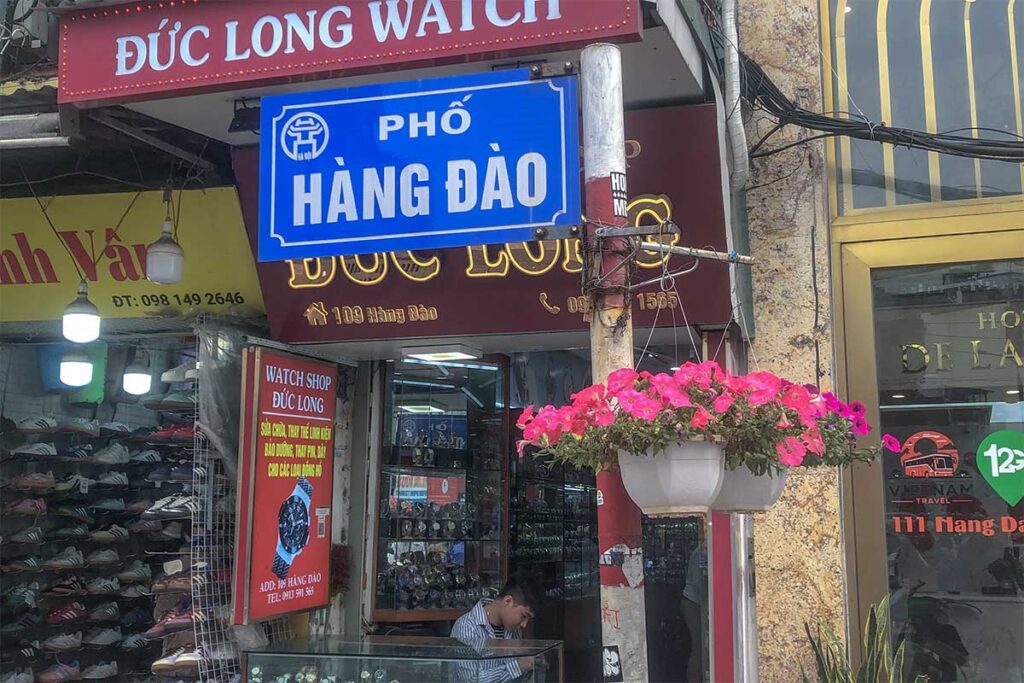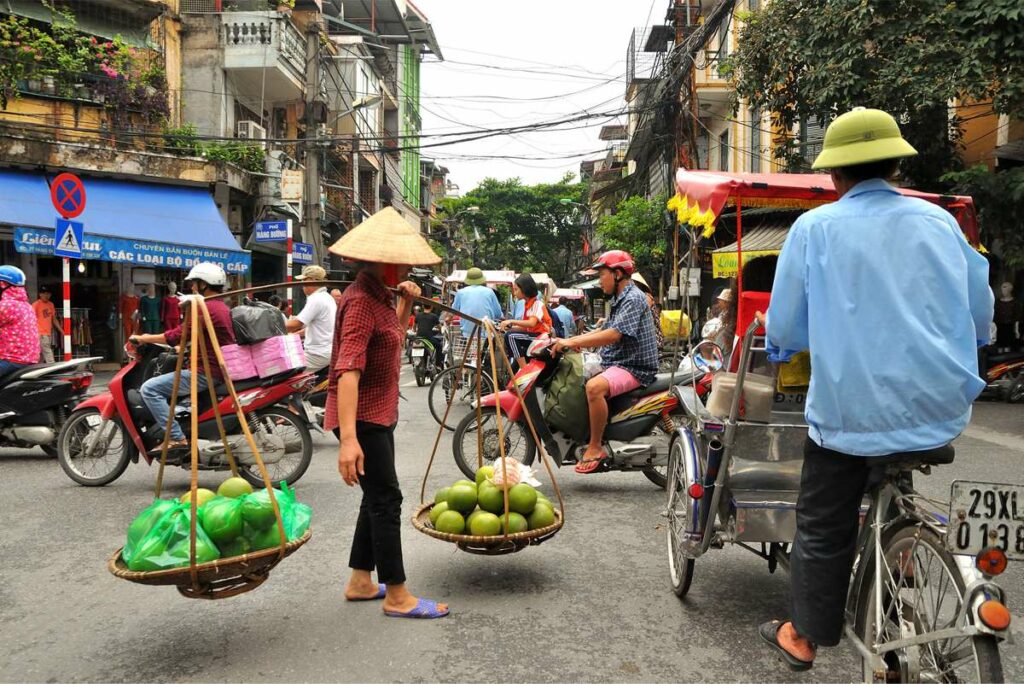What does “Hanoi 36 Streets” mean?
The term “Hanoi 36 Streets” refers to a historic network of streets in the Old Quarter that were originally organized by guilds — each specializing in a particular craft, trade, or product. Most of these streets begin with the word “Hàng,” which translates to “goods” or “merchandise,” followed by the item that was traditionally sold there — like Hàng Bạc (Silver Street) or Hàng Mã (Paper Offerings Street).
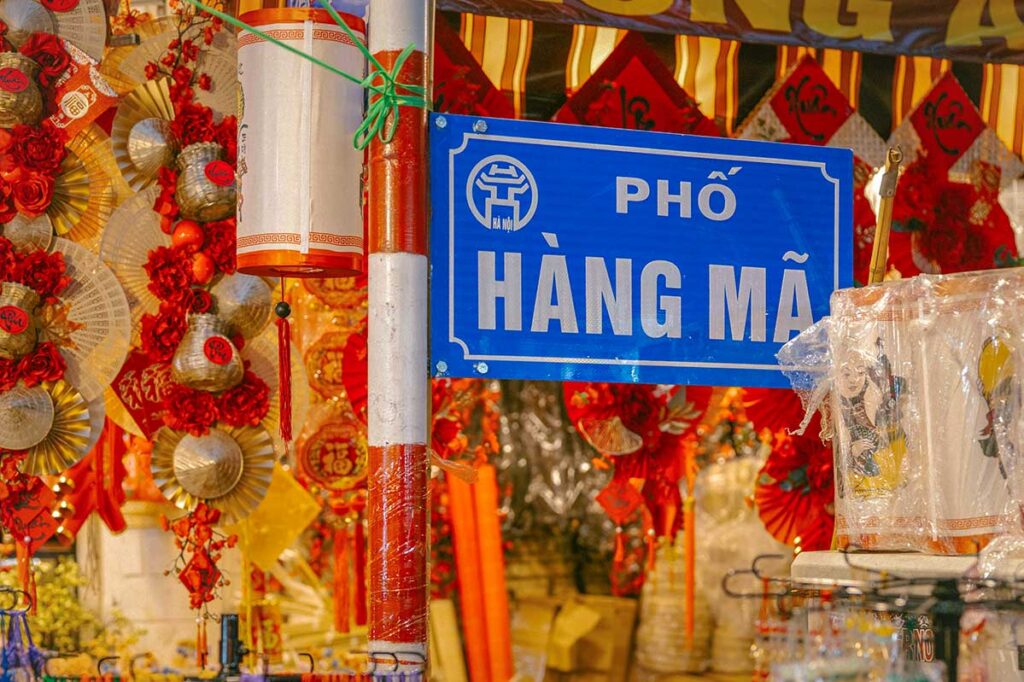
Despite the name, the Old Quarter actually contains more than 36 streets today. The number 36 is symbolic, possibly referring to the original 36 guilds or simply used to represent “many” in traditional Vietnamese culture. Over time, some streets have kept their craft-based identity, while others have adapted to modern businesses — but the legacy of trade, community, and cultural identity still defines the area.
History of Hanoi 36 Streets
11th Century – The Capital Moves to Thang Long
The story of the Hanoi 36 Streets begins in the 11th century, when Emperor Ly Thai To relocated the capital to Thang Long, now central Hanoi. As trade flourished, artisans from across the region settled near the royal citadel, forming a dense commercial district that would become the Old Quarter.
Guilds and Street specialization
Traders and craftsmen grouped together based on their profession, creating guilds for everything from silversmithing to paper goods. These communities were organized by craft, with each street becoming known for a specific product. This led to the now-famous pattern of street names beginning with “Hàng” (meaning “goods” or “merchandise”), like Hàng Bạc (Silver Street) and Hàng Mã (Paper Offerings Street).
Evolution into Permanent streets
What began as temporary marketplaces developed into permanent residential-trade streets, where artisans lived, worked, and sold their goods. The tightly packed layout, tube houses, and shared temples reflected a community built around both trade and tradition.
French Colonial Era – Modernization and Renaming
In the late 19th and early 20th centuries, French colonial authorities made significant changes. Streets were renamed, and many lakes, canals, and streams — including those around Cầu Gỗ Street — were filled in to expand the road network. French architecture appeared alongside traditional buildings, and tax-controlled markets like Đồng Xuân were developed to centralize commerce.
Post-1950s – Urban growth and Economic shift
After independence, Hanoi’s Old Quarter became more residential. Population growth and economic change led to a decline in traditional crafts. Many guilds disappeared or moved, replaced by general shops, tailors, food stalls, and later, tourism services. Despite this transformation, the street names, layout, and layered history still preserve the soul of the original 36 guild streets.
Full list of the 36 Streets
Despite its name, the Hanoi 36 Streets actually refers to a symbolic number tied to the Old Quarter’s original guild-based layout — not a literal street count. Many of these streets still carry their historical names and reflect the trades once practiced there. Below is a list of the most commonly recognized 36, including their traditional craft or specialty and English translations where relevant.
Craft & Textile-Related Streets
- Hàng Bông – Cotton Street (textiles and tailoring)
- Hàng Đào – Pink Silk Street (dyed silk and fabrics)
- Hàng Gai – Rattan/Silk Street (now mostly silk products and tailoring)
- Hàng Vải – Cloth Street (fabrics and textiles)
- Hàng Thêu – Embroidery Street (now mostly faded)
- Hàng Chỉ – Thread Street (tailoring materials)
Jewelry, Metal & Hardware Streets
- Hàng Bạc – Silver Street (jewelry, silversmiths)
- Hàng Thiếc – Tin Street (tinsmithing, mirrors, metal boxes)
- Hàng Đồng – Copper Street (metal goods and traditional items)
- Hàng Khoai – Sweet Potato Street (name origin unclear; some iron goods sold now)
Basketry, Bamboo & Woodcraft
- Hàng Tre – Bamboo Street (bamboo poles and baskets)
- Hàng Mây – Rattan Street (rattan goods and souvenirs)
- Hàng Gỗ – Wood Street (wooden items and household tools)
Packaging, Containers & Paper
- Hàng Mã – Paper Offerings Street (spiritual items, festival decorations)
- Hàng Thùng – Barrel Street (fish sauce and water barrels)
- Hàng Hòm – Box/Coffin Street (wooden chests and funerary boxes)
- Hàng Da – Leather Street (now mostly clothing and shoes)
Food, Herbs & Sauces
- Hàng Buồm – Sail Street (now known for street food and snacks)
- Hàng Đường – Sugar Street (candied fruit, dried sweets)
- Hàng Muối – Salt Street (seasonings and preserved goods)
- Hàng Mắm – Fish Sauce Street (fermented seafood and condiments)
- Lãn Ông – Herbal Medicine Street (traditional remedies, apothecaries)
Household Goods & Tools
- Hàng Chiếu – Mat Street (woven sleeping mats)
- Hàng Bút – Brush Street (calligraphy and art supplies)
- Hàng Quạt – Fan Street (paper fans, ceremonial goods)
- Hàng Rươi – Sandworm Street (seasonal food, rare)
- Hàng Cá – Fish Street (wet market goods)
Religion, Ritual, and Miscellaneous
- Hàng Lược – Comb Street (ritual combs and traditional items)
- Hàng Trống – Drum Street (ceremonial drums, paper art)
- Hàng Khay – Tray Street (wooden trays and altars)
- Hàng Bè – Raft Street (bamboo rafts, near riverside)
- Hàng Thiếp – Gold Leaf Street (decorative paper and prints)
- Hàng Ngang – Cross Street (general goods, now clothing)
- Hàng Cân – Scale Street (weighing scales and tools)
This list may vary slightly depending on source, as the definition of the Hanoi 36 Streets has evolved over time — but these are among the most historically and culturally recognized. In the next section, we’ll take a closer look at 10 of the most iconic streets to visit today.
10 Most iconic streets to explore
Not all of the Hanoi 36 Streets are equally relevant for travelers today — some have faded into quiet residential areas, while others have transformed into tourist hotspots, shopping streets, or food hubs. These 10 streets stand out for their historical importance, vibrant atmosphere, or unique experiences, and are among the best places to explore if you want to understand the living spirit of Hanoi’s Old Quarter.
1. Hàng Gai – Silk & Souvenirs
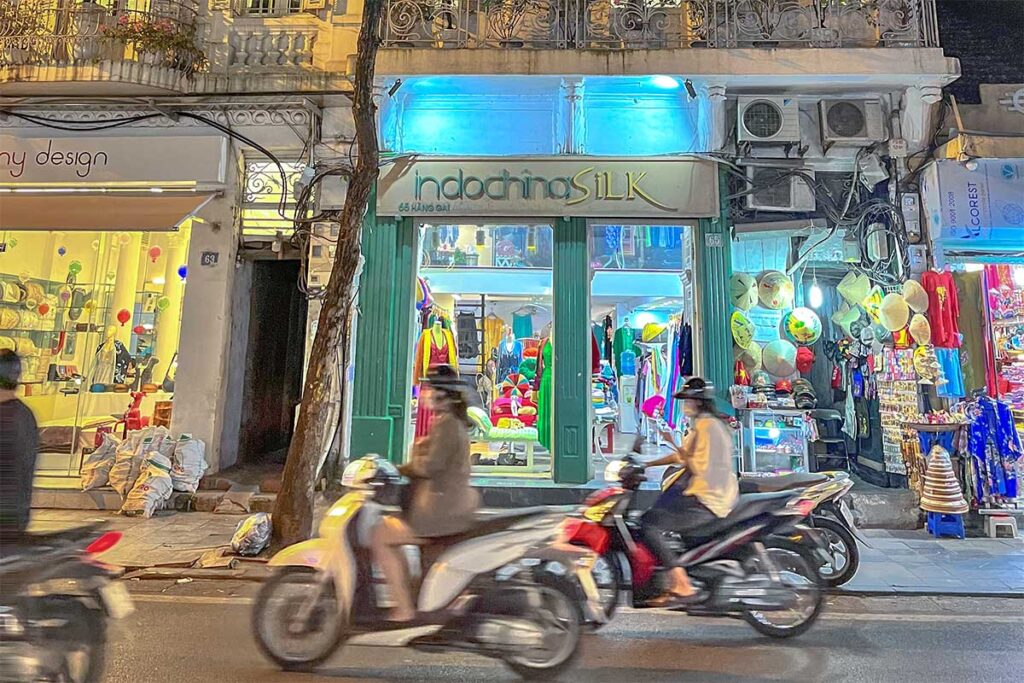
Located just steps from Hoan Kiem Lake, Hàng Gai is one of the most polished and tourist-friendly streets in the Old Quarter. Historically tied to rattan and later silk production, the street is now lined with silk tailors, art galleries, and souvenir shops. It’s an excellent place to pick up high-quality fabric, embroidery, or custom-made clothes. Prices are higher here than in markets, but the quality and service generally reflect that. Bargaining is still common — just do it with a smile.
2. Hàng Bac – Jewelry & Old Quarter Access
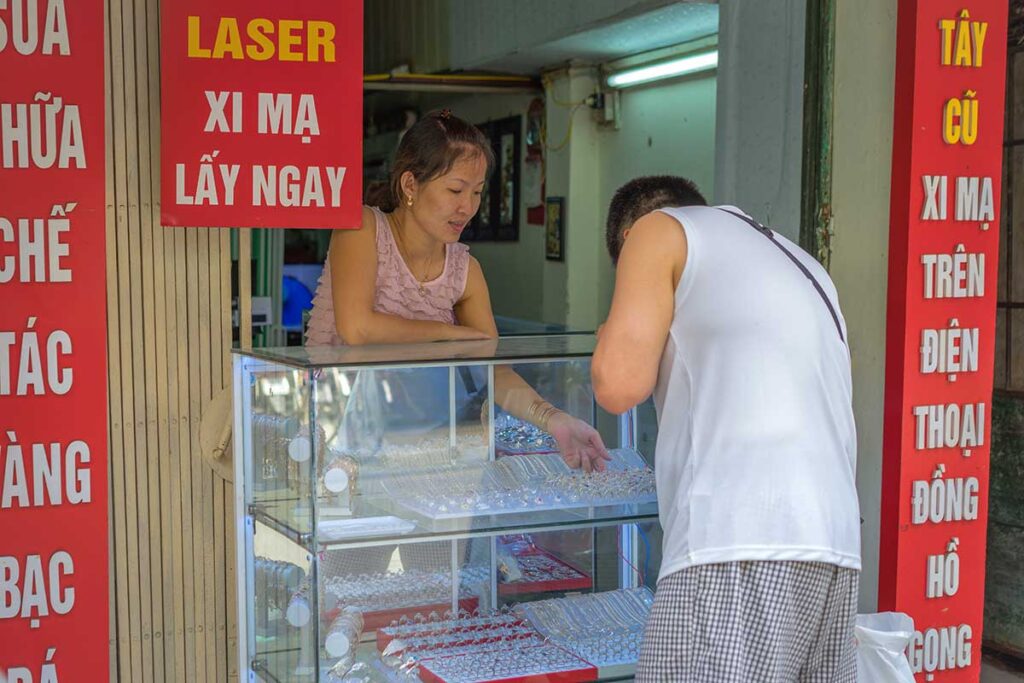
Once the heart of Hanoi’s silversmith guild, Hàng Bạc (Silver Street) still retains its identity today with a mix of traditional jewelry stores and more modern offerings. It’s also a key connector street between Ta Hien, Luong Ngoc Quyen, and other nightlife hotspots, so the foot traffic is steady day and night. While some shops cater mainly to tourists, others still showcase local craftsmanship if you know where to look.
3. Mã Mây – Traditional Architecture & Tourism
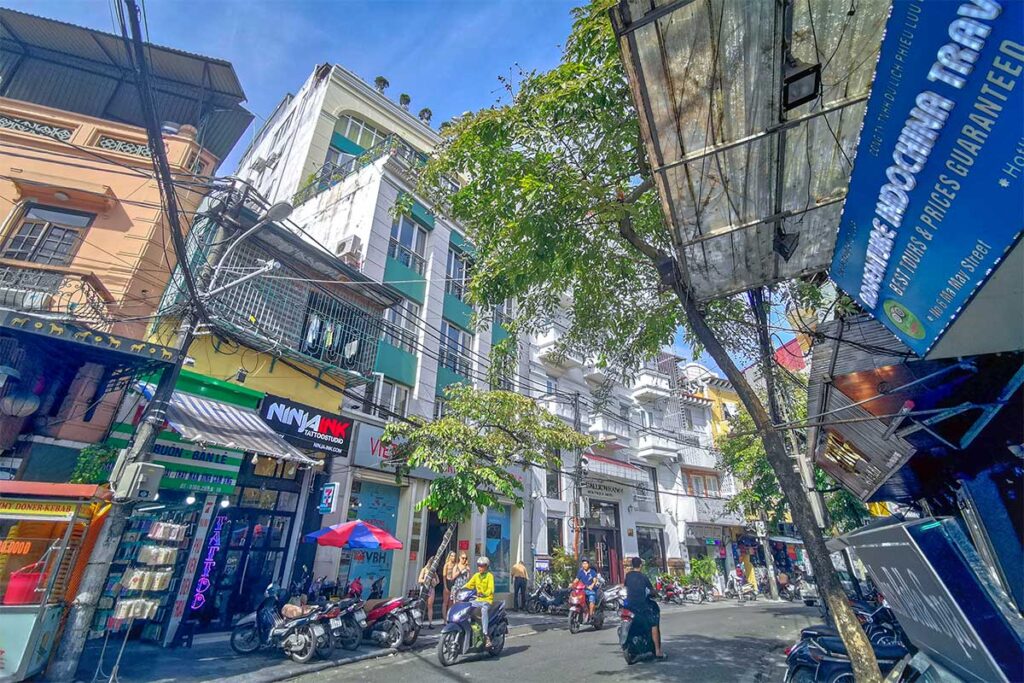
Mã Mây is one of the most visited streets in the Old Quarter, thanks to its blend of history and tourist-friendly services. Originally two streets — one for rattan (Mây) and one for ceremonial paper (Mã) — they were merged and now host a variety of hostels, travel agencies, and eateries. The highlight here is the Heritage House at 87 Ma May, a restored example of traditional Hanoi architecture. Visit during the day for a quieter look at the buildings; by night, the street is alive with travelers heading out for dinner or drinks.
4. Hàng Mã – Festival Colors & Paper Goods
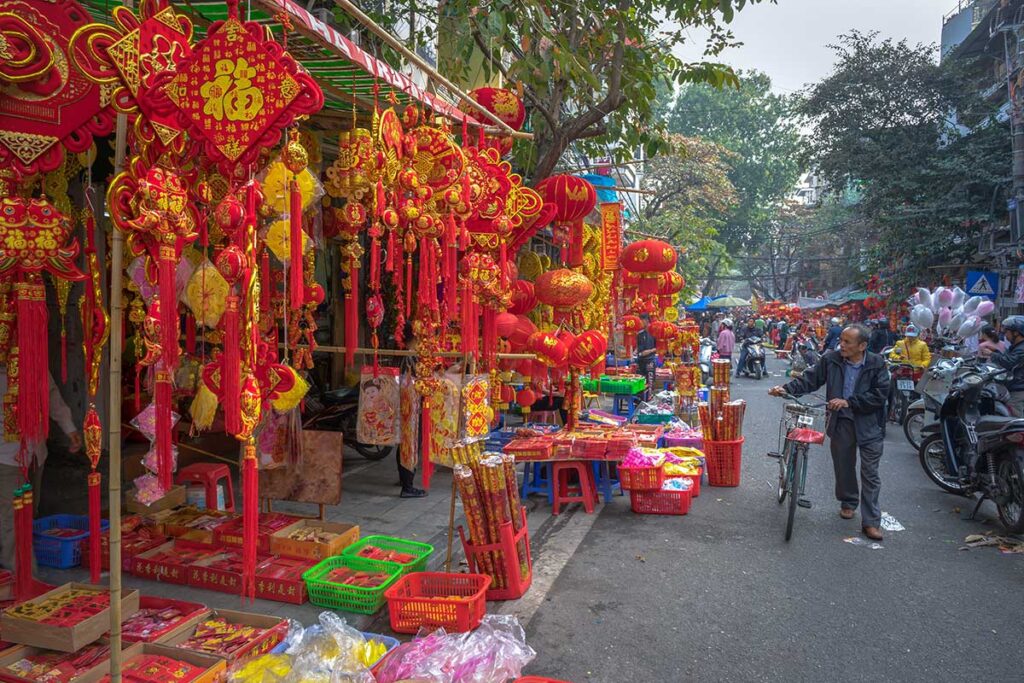
No street captures the festive spirit of Hanoi like Hàng Mã. Traditionally dedicated to paper offerings used in ancestral worship, it’s now a go-to location for colorful decorations, especially before Tet and the Mid-Autumn Festival. You’ll find paper lanterns, ceremonial items, toys, and seasonal displays — all packed into one narrow, glowing street. It’s crowded and chaotic at peak times, but visually stunning and deeply rooted in Vietnamese spiritual life.
See our full guide to Hang Ma Street
5. Hàng Đào – Central Walking Street & Night Market
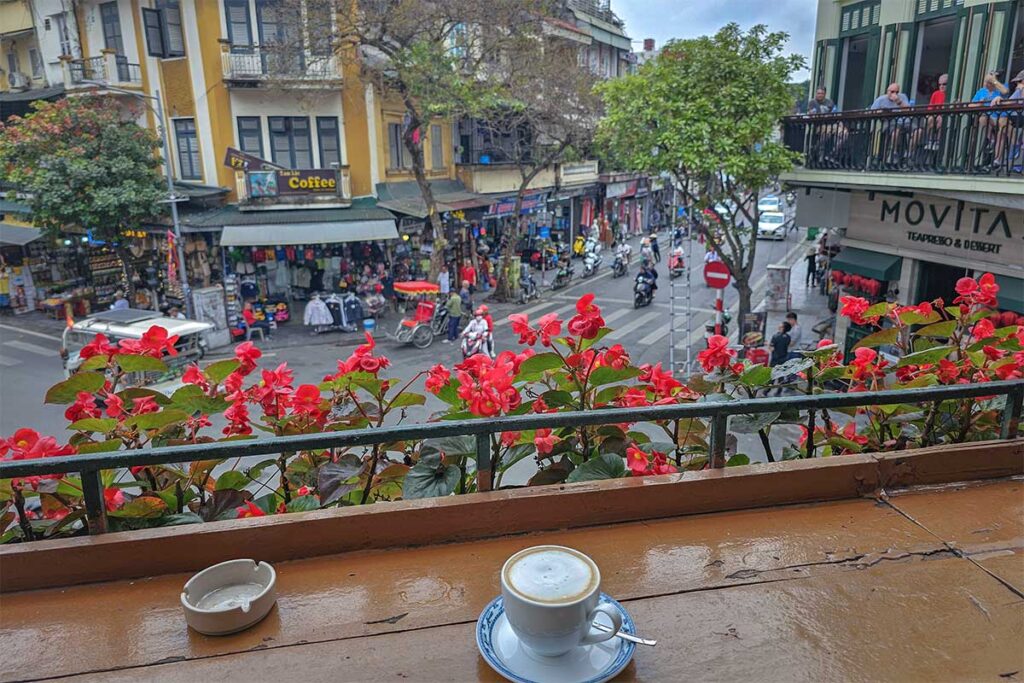
Hàng Đào is one of Hanoi’s oldest streets and serves as a major pedestrian route between Hoan Kiem Lake and Dong Xuan Market. Once famous for its dyed silks (Đào refers to apricot blossom pink), the street is now dominated by fashion shops and budget clothing stalls. On weekends, it becomes part of the night market route, buzzing with locals and tourists browsing souvenirs, snacks, and street food. It’s a good place for people-watching — just expect crowds and tourist pricing.
6. Hàng Tre – Bamboo, Baskets & More Local Vibe
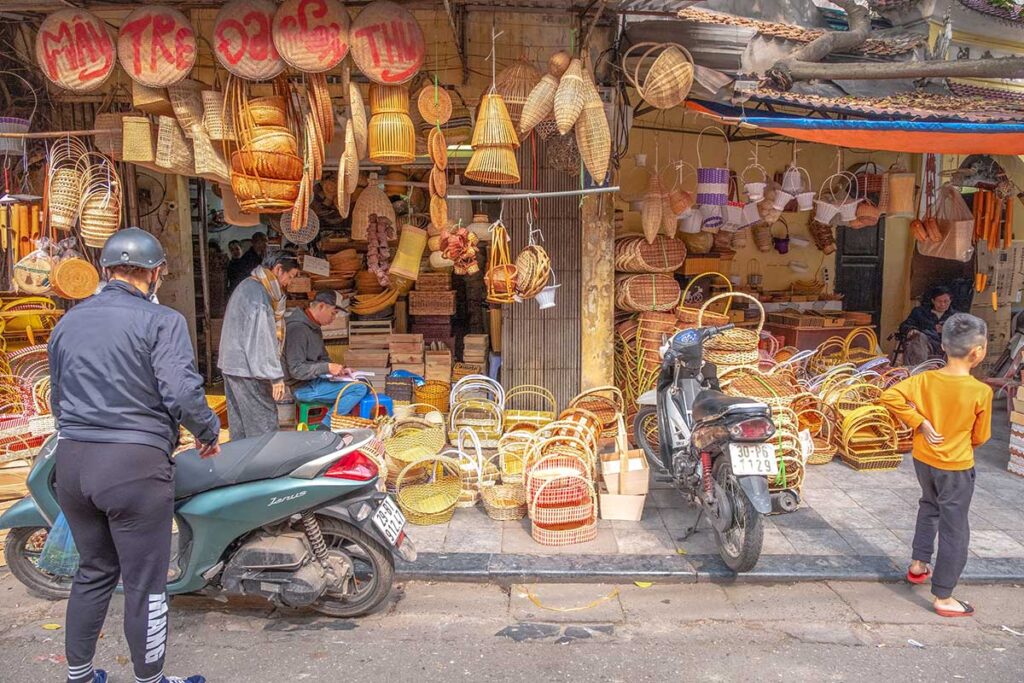
Tucked between more commercial areas, Hàng Tre (Bamboo Street) is quieter than most. Historically a center for bamboo poles and woven goods, the street still hosts some shops selling baskets and everyday items. It’s more local in feel, and although not flashy, it offers a pleasant break from the busier tourist zones nearby. A good choice for a slower, more atmospheric walk.
7. Hàng Thiec – Living Craft: Tinsmiths at Work
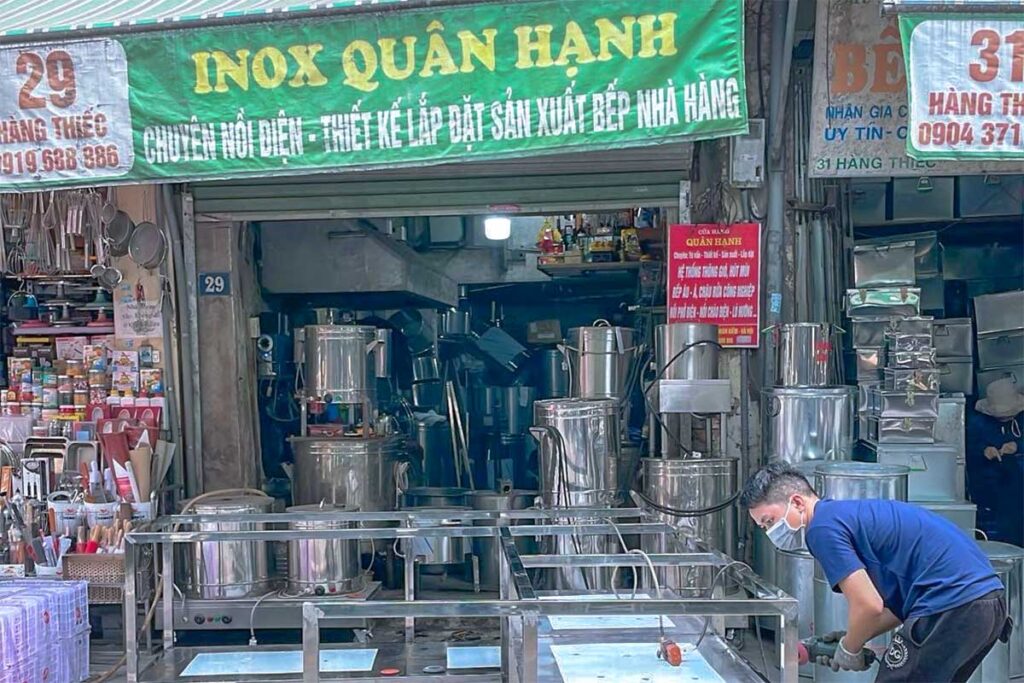
One of the few places in the Old Quarter where you can still witness traditional craftsmanship in action, Hàng Thiếc (Tin Street) remains home to a handful of working tinsmiths. You’ll hear the clang of hammers on metal as craftsmen shape boxes, lanterns, and containers right on the sidewalk. It’s gritty and real — a reminder of the Old Quarter’s roots. For those interested in authentic experiences and photography, this street is a hidden gem.
8. Luong Văn Can – Souvenirs & Toys
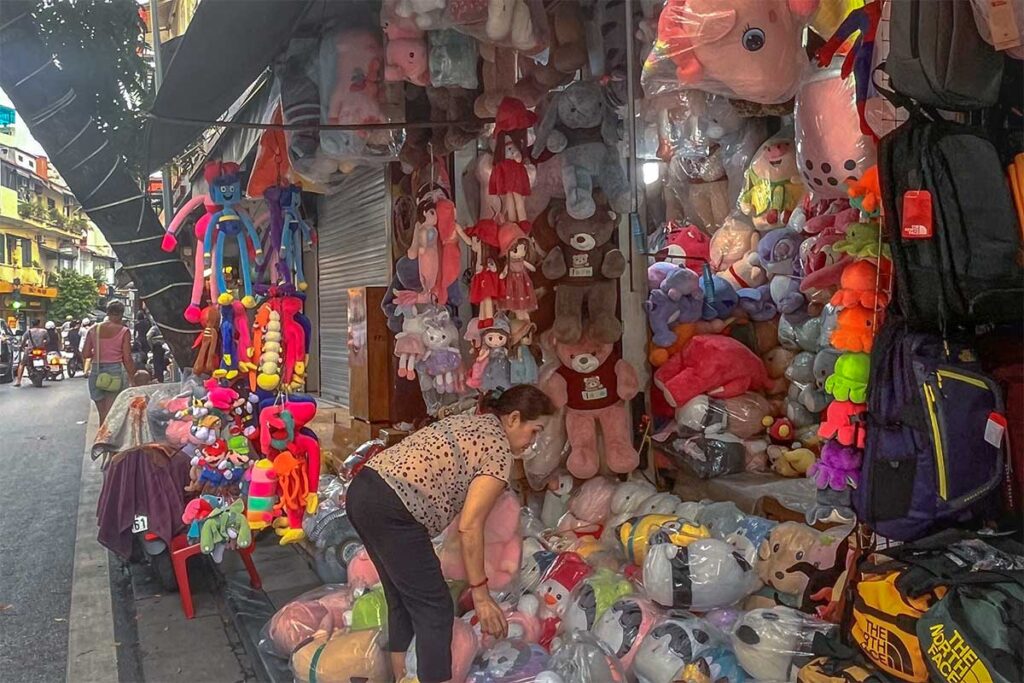
Running parallel to Hang Dao, this colorful street is known for its playful, chaotic vibe. Traditionally associated with toy-making and household goods, Lương Văn Can is now lined with souvenir shops, kids’ toys, and seasonal items. Some of it is tacky, some of it is fun — but either way, it’s a lively spot that feels distinctly Vietnamese.
9. Đong Xuân Street – Gateway to Hanoi’s Largest Market
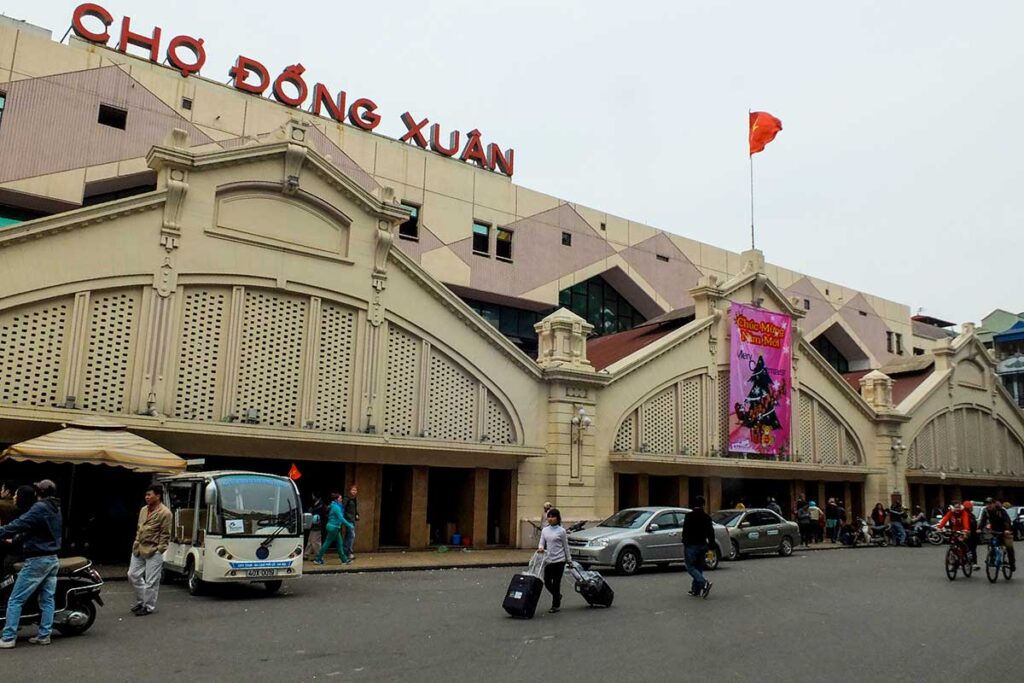
While the street itself may not be the most attractive, Đồng Xuân’s claim to fame is its market — the largest and busiest in Hanoi. Built in the 19th century by the French and renovated in the 1990s, Dong Xuan Market sells everything from bulk spices and clothes to electronics and souvenirs. The surrounding streets, including Dong Xuan itself, are a blend of wholesale business and chaotic everyday commerce. It’s not always pleasant, but it’s definitely authentic.
10. Hàng Buom – Street Food & Nightlife
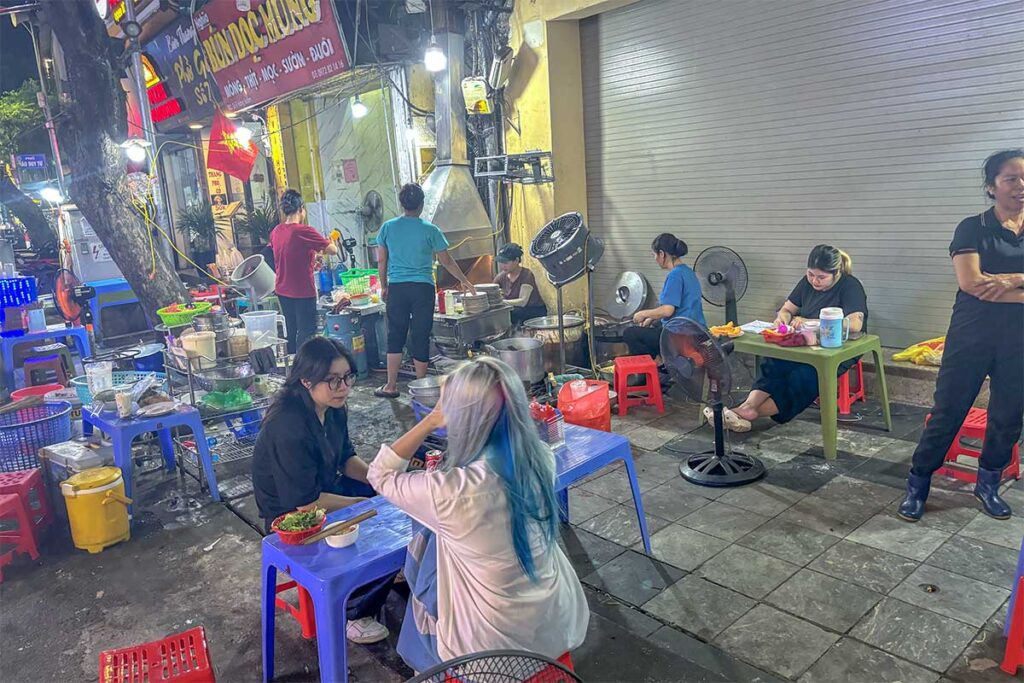
Once known for sail-making, Hàng Buồm is now one of the best streets in Hanoi for street food and nightlife. In the evening, vendors set up stalls selling Vietnamese snacks, grilled meat, and local drinks. The street also connects well with Ma May and Ta Hien, making it a natural extension of any night out. If you’re hungry and curious, this is a great place to start exploring with your stomach.
How to discover Hanoi 36 Streets
The best way to experience the Hanoi 36 Streets is to slow down and become part of the city’s daily rhythm. It’s not just about ticking off famous names — it’s about noticing the crafts still practiced on the sidewalk, sipping coffee while the world passes by, or chatting with a vendor over a cold bia hoi. These activities will help you go beyond the surface and experience the Old Quarter as something living and layered.
1. Walk the maze of alleyways
Wandering on foot is the most authentic way to explore the 36 Streets. You can go self-guided, stopping wherever catches your eye, or hire a local guide who can explain the history behind each street name and point out traditional architecture you might otherwise miss.

Morning and late afternoon are the best times to walk — early for quiet streets and local life, later for the evening buzz, lights, and food.
2. Sip a coffee at a local café
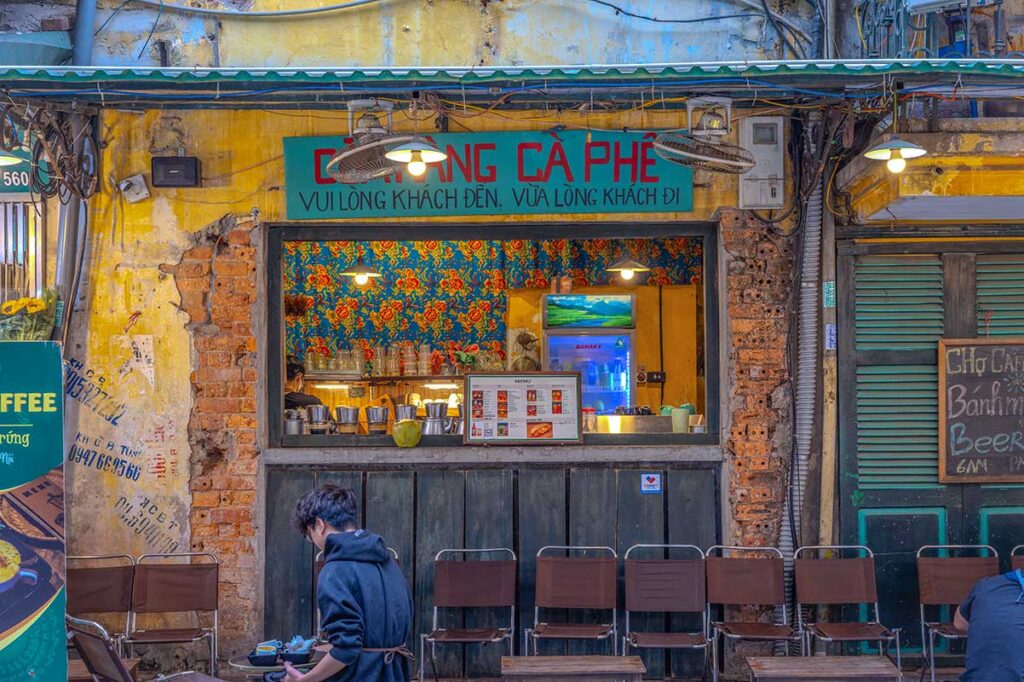
Scattered across the Old Quarter are tiny cafés tucked behind open doors, rooftop terraces with street views, and no-frills stools facing the sidewalk. Take a break with a traditional egg coffee, a strong drip cà phê đen, or a sweet cà phê sữa đá. Some cafés even sit on the upper floors of old tube houses, offering a quiet look over the busy chaos below.
3. Enjoy a street food experience
Each street has its own culinary personality — grilled meats on Hàng Buồm, sweet snacks on Hàng Đường, or herbal remedies with strong aromas on Lãn Ông. You could spend a day snacking from one block to the next.
If you want a deeper experience, consider joining a guided street food tour. It’s a great way to discover hidden spots, try dishes you might overlook, and hear the stories behind them.
4. Shop local
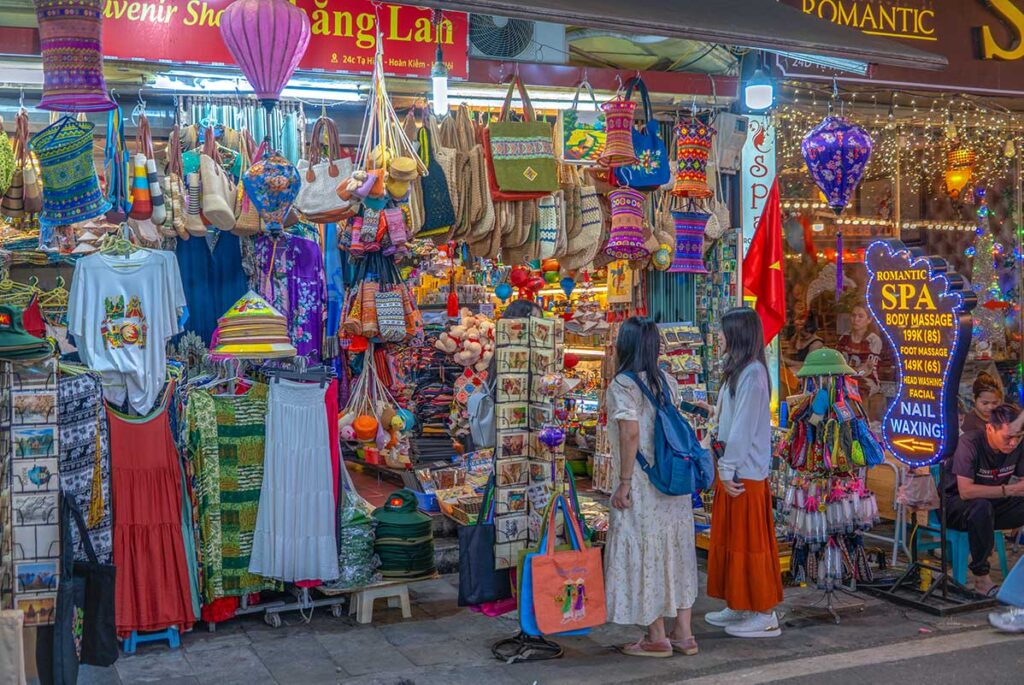
Shopping in the 36 Streets isn’t about malls or big-brand stores. It’s about handmade silver on Hàng Bạc, fine silk scarves on Hàng Gai, or playful souvenirs on Lương Văn Can. Some streets specialize in just one item, while others are a quirky mix. Prices vary, so bargaining is common — just stay polite and friendly.
5. Take a cyclo ride
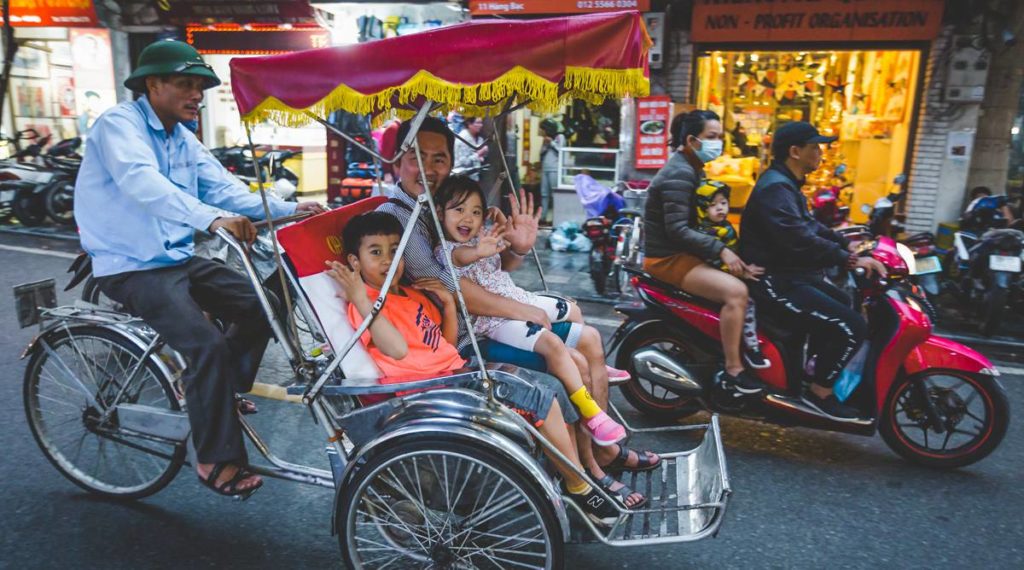
For a slower, old-fashioned way to experience the streets, hop on a cyclo (three-wheeled bicycle taxi). It’s a touristy option, but still a fun and atmospheric one — especially for first-time visitors or relaxed photo-taking. Rides are best in the early evening when the streets light up but aren’t yet too packed.
6. Join locals for a Bia Hoi
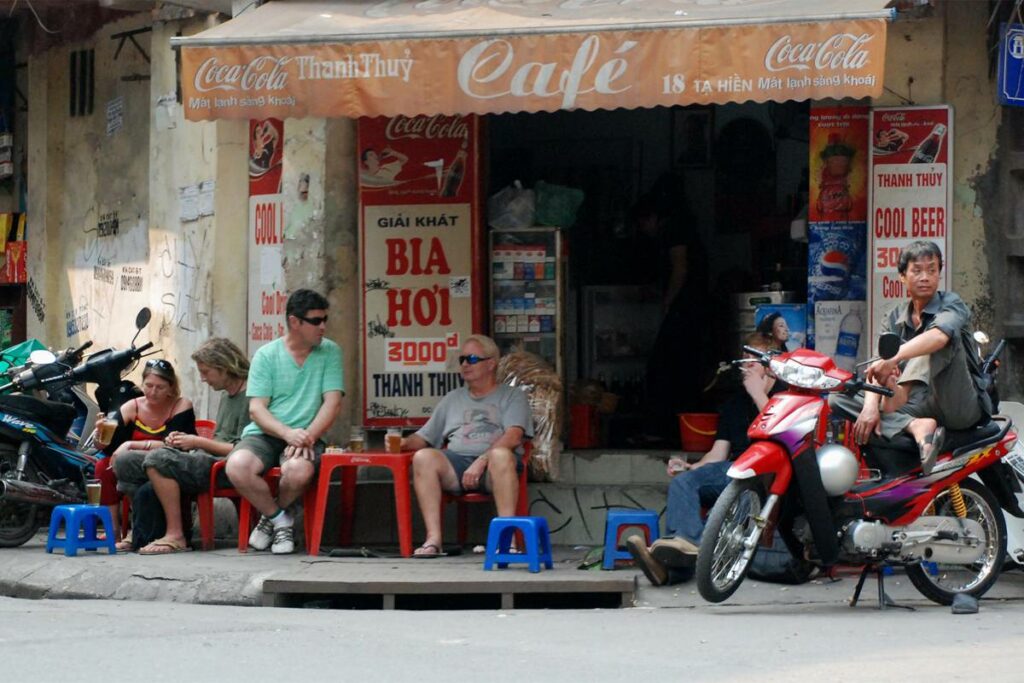
Nothing connects you to the rhythm of Hanoi quite like sitting on a plastic stool with a cold glass of bia hoi (fresh draft beer). Ta Hien is the most famous spot, but it’s also the most touristy. For something more local, try side streets like Hàng Buồm, Hàng Giấy, or even quieter corners of Hàng Tre — where the beer is just as cold and the crowd more local.
